2 Ingredient Chocolate Mousse (Quick & Easy Hack)
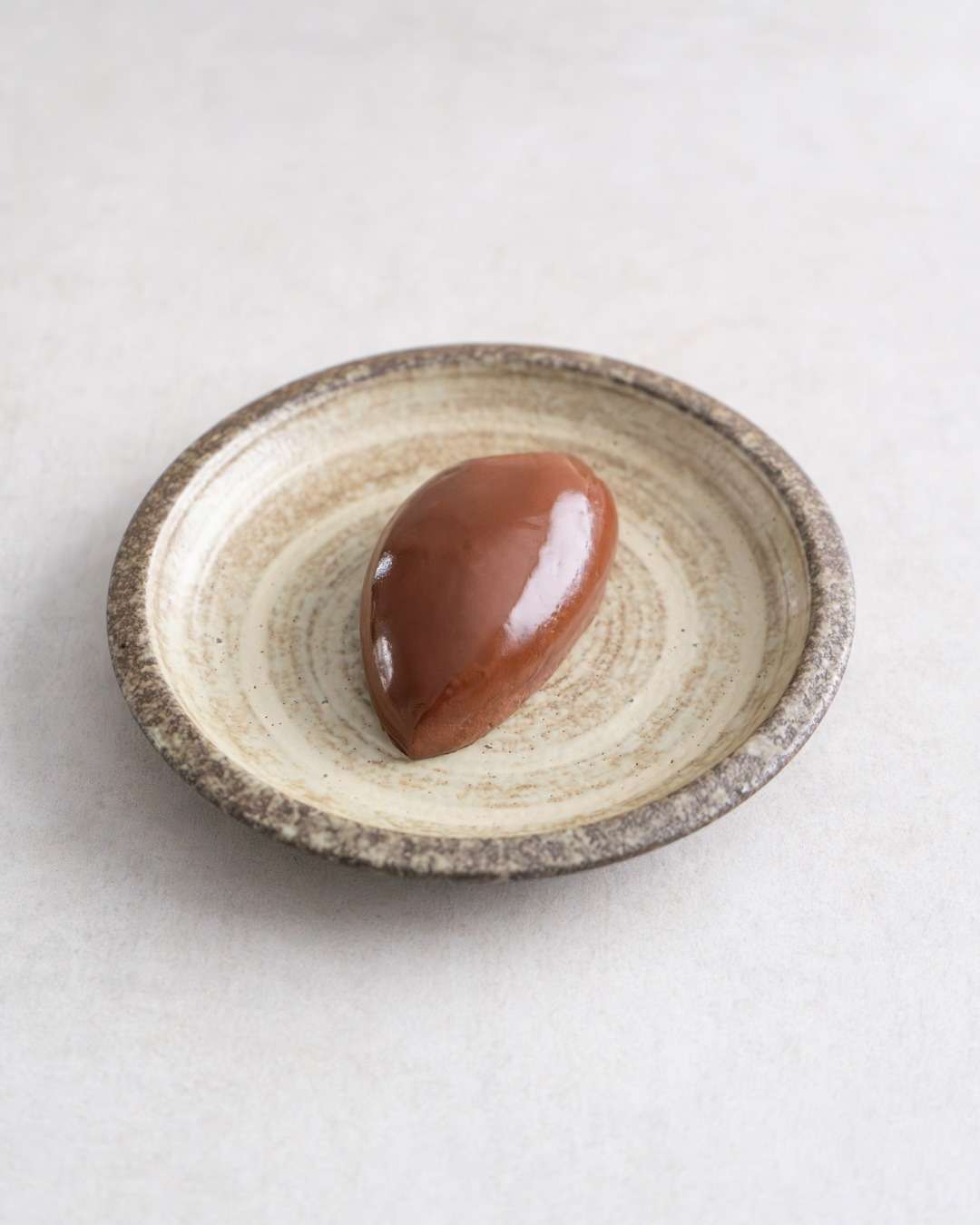
If you ever added a small amount of water to melted chocolate, you’ll have witnessed the unfortunate transformation from a luxurious texture to a stiff paste. The chocolate seized. But did you know that with the right balance of water and technique, this same reaction can be transformed into a rich chocolate mousse?
How Does It Work?
The process behind this chocolate mousse was a discovery made by the French chemist Hervé This, also known as the father of molecular gastronomy. He realised that if you add a large enough quantity of water, the fats in the chocolate do not clump together, but suspend into a smooth liquid instead. If you then slowly cool the chocolate down while whisking, the bonds begin to form again and trap air inside the fat molecules, thereby creating a chocolate mousse.
The process takes barely 10 minutes. You can add the boiling water straight to a bowl with chocolate, let it melt entirely and then whisk it over an ice bath for just 5 minutes. The result is a surprisingly rich chocolate mousse with an incredibly pure chocolate flavour. Thanks to the cooled down water, it almost seems refreshing compared to a heavy chocolate dessert.
Ingredients You’ll Need to Make Chocolate Mousse + Substitutions
- dark chocolate: I used 74% dark chocolate in this recipe, but most dark chocolate between 65% – 85% will work. Dark chocolate is mildly sweetened with a high percentage of pure chocolate, giving it the perfect luxurious flavor for this dessert. Please see the guide below on how much water you need for the chocolate you’re using, as ratios differ depending on the percentage of pure chocolate.
- ice cubes: these are essential to cool down the melted chocolate steadily so that it forms a luxurious mousse
- water: you’ll need some water along with the ice cubes, but also some hot water to melt the chocolate. If you like, you can substitute the hot water to flavor the mousse. Try freshly brewed coffee instead, or a mix of hot water with a dash of dessert wine for a boozy kick.
- Optional: take the finished mousse to the next level by serving it with some flaky salt.
How Much Water to Chocolate Do I Need to Use?
I based my recipe on 74% dark chocolate to which I added 0.84x water. When I compared this to other recipes, it seems that with every percent decrease of pure chocolate, you need to add 0.01x less water. The examples below make it a little easier to follow:
For 65% dark chocolate add 75% water (multiply the choocolate by x0.75)
For 70% dark chocolate add 80% water (multiply the choocolate by x0.8)
For 74% dark chocolate add 84% water (multiply the chocolate by x0.84)
For 75% dark chocolate add 85% water (multiply the chocolate by x0.85)
And so on…
While it’s fine to add a little less (it’ll result in a denser mousse), it’s important not to exceed the suggested amount of water, because the mousse won’t hold its shape. So I’d advise to use a digital scale to weigh out exactly how much you’re adding, rather than eyeballing it with a measuring jug.
Troubleshooting
There are three things that can go wrong, all of which are easy to fix by melting the chocolate again and making adjustments.
- If the chocolate remains liquid and doesn’t form a mousse at all, there’s not enough fat in the mixture. Add another handful of chocolate, gently melt it all in a sauce pan and whisk it again over the ice bath.
- If the mousse becomes too dense at the end, then there’s too much fat and you need to add more water when melting the chocolate again.
- The chocolate can also become grainy, which is a sign that you over-whisked it. In that case, just melt it again and give it another go, whisking a little less vigorously and taking the bowl out of the ice a little earlier.
How to Make Chocolate Mousse (Step-by-Step)
Prepare the ice water. Bring a kettle of water to the boil. In the meantime, add 2 large handfuls of ice cubes to a large bowl and pour in enough cold water to almost reach the top of the ice.
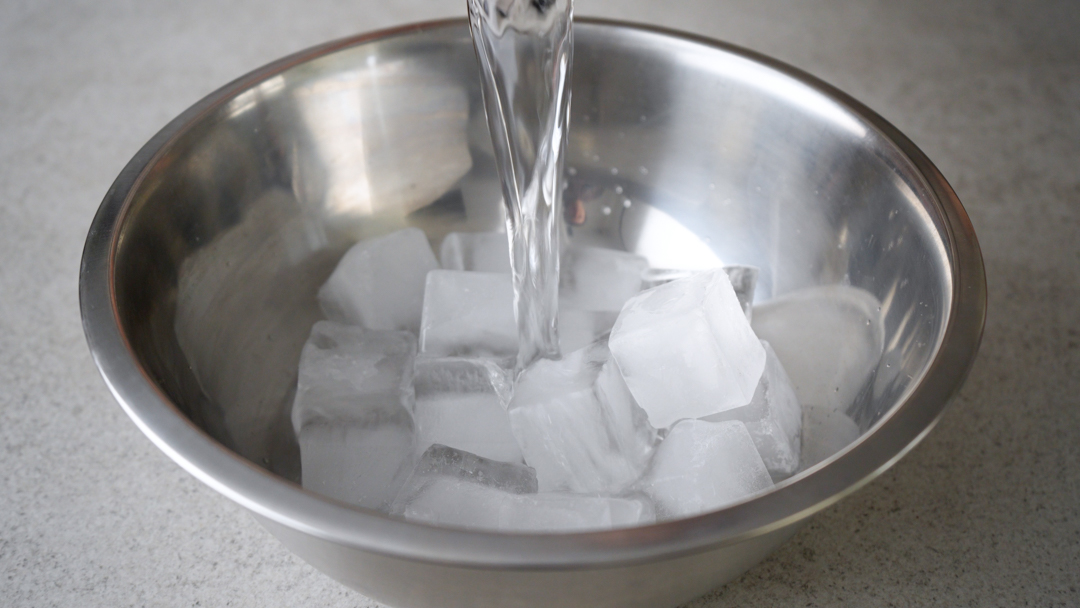
Melt the chocolate. Break the chocolate into a medium bowl (that easily fits into the large bowl).
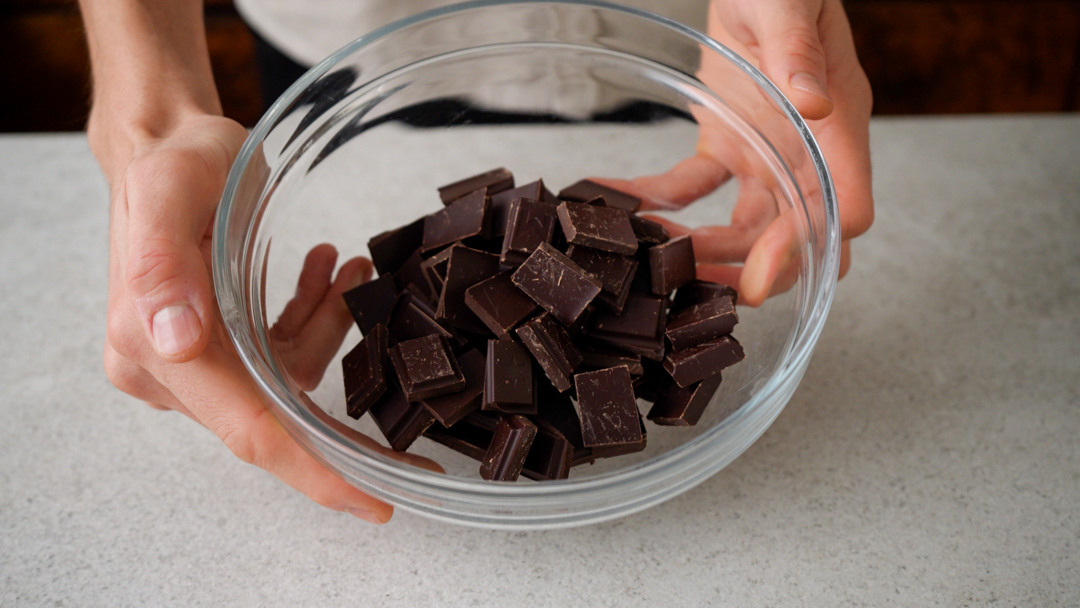
Pour over 210ml of boiling water (don’t exceed this amount or the mousse won’t hold its shape).

Whisk it until the chocolate has completely melted.
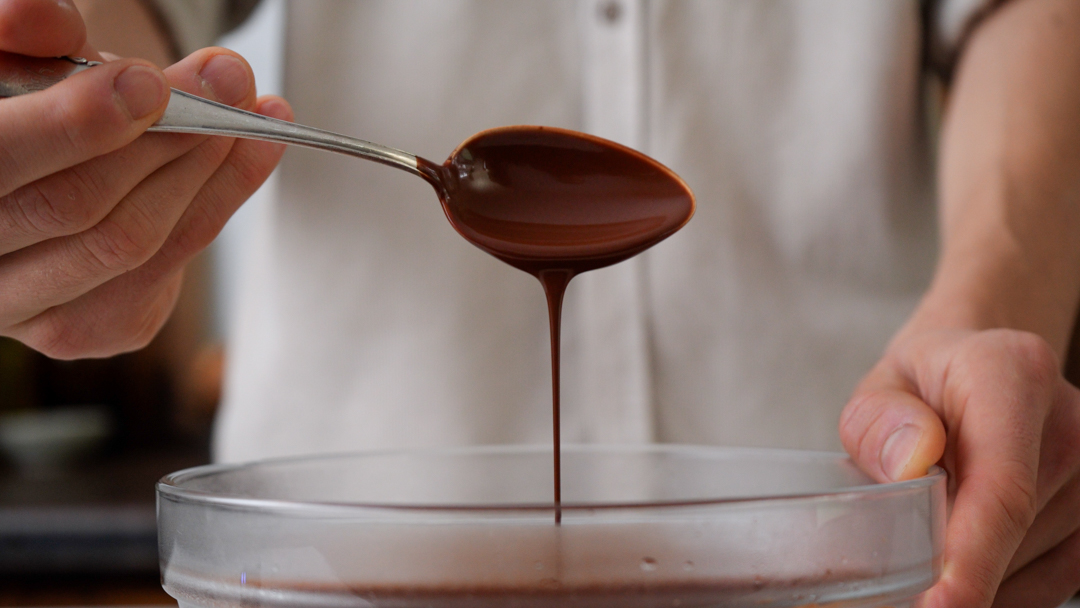
Let the chocolate seize into a mousse. Now place the bowl with the chocolate into the bowl with the ice and whisk until the chocolate begins to thicken (4-5 minutes), thereby incorporating air. Once it has thickened to a point where the whisk leaves thick ribbons and the surface doesn’t instantly level out when you drizzle the chocolate, remove the bowl from the ice.
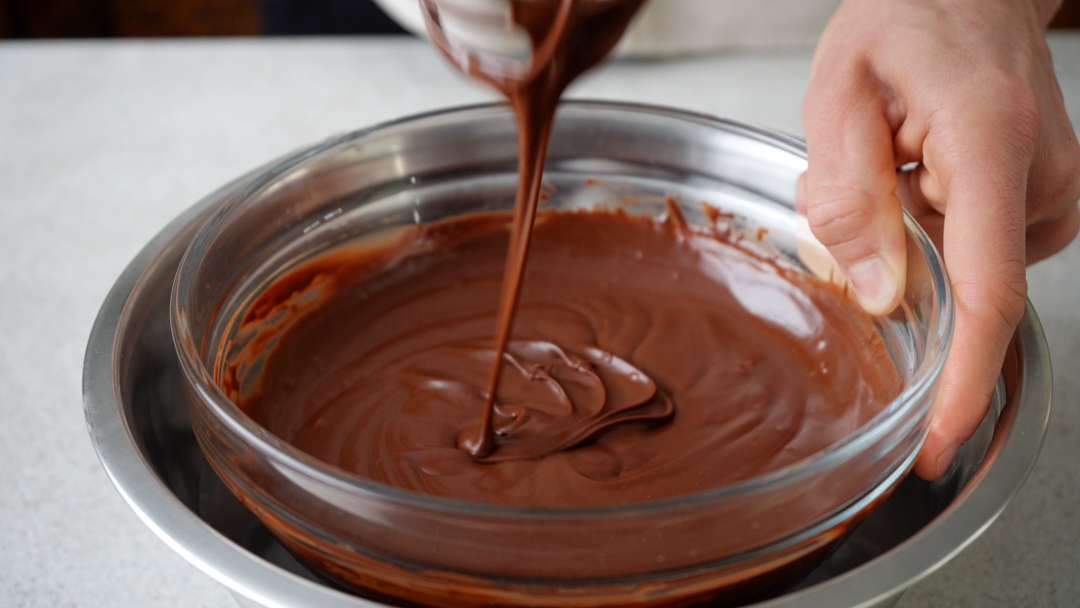
Continue whisking for another 30 seconds as it cools down even further. This happens really quickly, so rather remove it too early and continue whisking it to see if it stiffens up into a mousse. If not, return it to the ice bath and cool it down a little more.
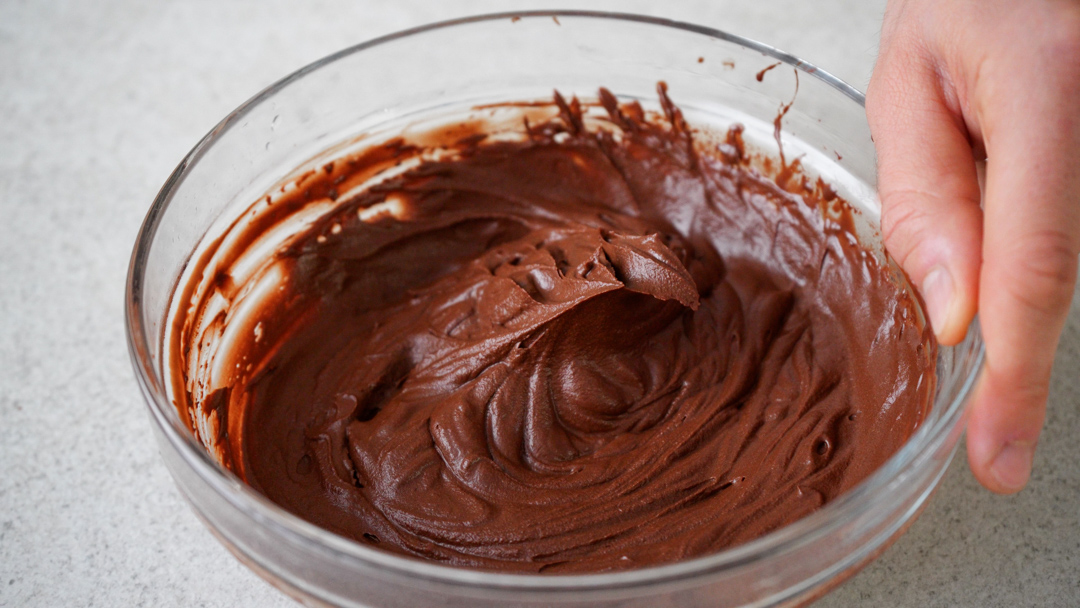
Serve. Either spoon the mousse into a glass or serve it on a plate. To do this elegantly, soak a tablespoon in very hot water to heat it up. Then make a quenelle by pushing the warm spoon through and finally around the chocolate mousse for a smooth egg shape.
Other Chocolate Desserts You Might Like:
- Chocolate Chip Cookies: turn leftover coffee grounds into incredible chocolate chip cookies
- Dark Chocolate Energy Balls: turn wholesome ingredients into an energy boost
- Avocado Chocolate Mousse: creamy avocados make the perfect base for a rich chocolate mousse
- Chocolate Salami: a salami made out of chocolate, perfect for festive occasions
Storage
You can store the finished chocolate mousse in the refrigerator for 3-4 days.
As an Amazon Associate I receive a small commission from affiliate links on this page.
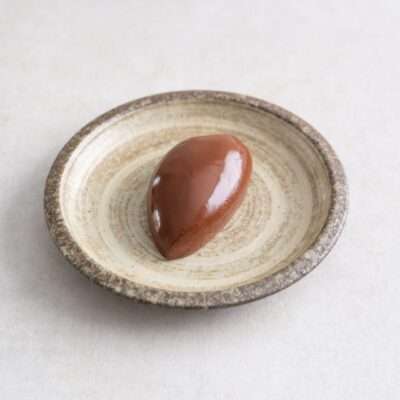
2 Ingredient Chocolate Mousse (Quick & Easy Hack)
Ingredients
- 500 g ice cubes
- 250 g 74% dark chocolate
Instructions
- Bring a kettle of water to the boil. In the meantime, add 2 large handfuls of ice cubes (around 500g) to a large bowl and pour in enough cold water to almost reach the top of the ice.
- Break the chocolate into a medium bowl (that easily fits into the large bowl) and pour over 210ml of boiling water. If using a different percentage of chocolate, please refer to the conversion guide above. Whisk it until the chocolate has completely melted.
- Now place the bowl with the chocolate into the bowl with the ice and whisk until the chocolate begins to thicken (4-5 minutes), thereby incorporating air. Once it has thickened to a point where the whisk leaves thick ribbons and the surface doesn’t instantly level out when you drizzle the chocolate, remove the bowl from the ice and continue whisking for another 30 seconds as it cools down even further. This happens really quickly, so rather remove it too early and continue whisking it to see if it stiffens up into a mousse. If not, return it to the ice bath and cool it down a little more.
- Either spoon the mousse into a glass or serve it on a plate. To do this elegantly, soak a tablespoon in very hot water to heat it up. Then make a quenelle by pushing the warm spoon through and finally around the chocolate mousse for a smooth egg shape. Optionally, serve with some flaky salt to accentuate the chocolate flavor.

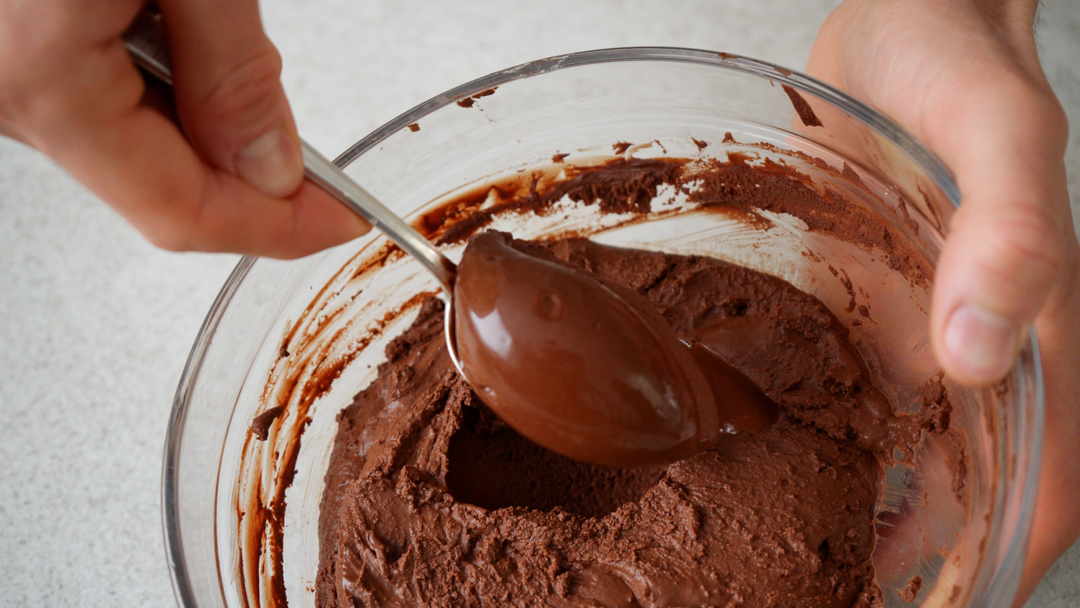
How do you “ melt” the mousse down when it does not set so I can add more chocolate? I assume over a saucepan of simmering water while whisking? That is the only part missing from your recipe. I tried it with milk chocolate but I must have used too much water as it did not even set in the fridge over night.
You can melt it the same way as you melted the chocolate (in a bowl over simmering water). It’ll just take a little longer. Try using dark chocolate for your next batch, if you can, as you need the right amount of cacao butter for it to seize into a mousse.
Hello, would this also work with 99%-100% chocolate?
Ooh, interesting question. I haven’t tried that yet, but in theory it should work. If you use 100% dark chocolate, you will probably need to add the same weight of boiling water.
I assume the chocolate you used is sweetened. We live in South America and our chocolate aka cacao is normally unsweetened. Suggestions for adding a non sugar sweetener?
I used 74% dark chocolate, so yes, there’s some added sugar. I haven’t tried this process with pure chocolate plus an added sweetener. It should work, but might require a bit of fine tuning. You can use any sugar alternative you like. Maple or agave syrup, for instance. Add it to the chocolate and then melt it together, before whisking it over ice.
I just made it, what an amazing process! So easy and its almost like magic! I was wondering if this also works with 50% chocolate, since I think the taste is now quite bitter.
Thanks a lot for the recipe!
Amazing, I’m glad you liked it! 50% is usually milk chocolate and the lower percentage and added ingredients will most likely hinder the chocolate from coming together into a mousse. You can, however, try adding a little bit of maple syrup or even sugar to the chocolate, when you melt it.
Hello, I looked into this method specifically to find a shelf stable option. Why is it that it needs to be refrigerated since its only water and milk. I tried it and left it on the counter overnight, and see no issue? Curious if you have found/know of one.
It’s more to preserve the texture, plus it’s quite satisfying to have the cold sensation when tucking into the mousse. But mixing water and chocolate will also impact the shelf life, so I wouldn’t keep it for much longer than a day at room temp.